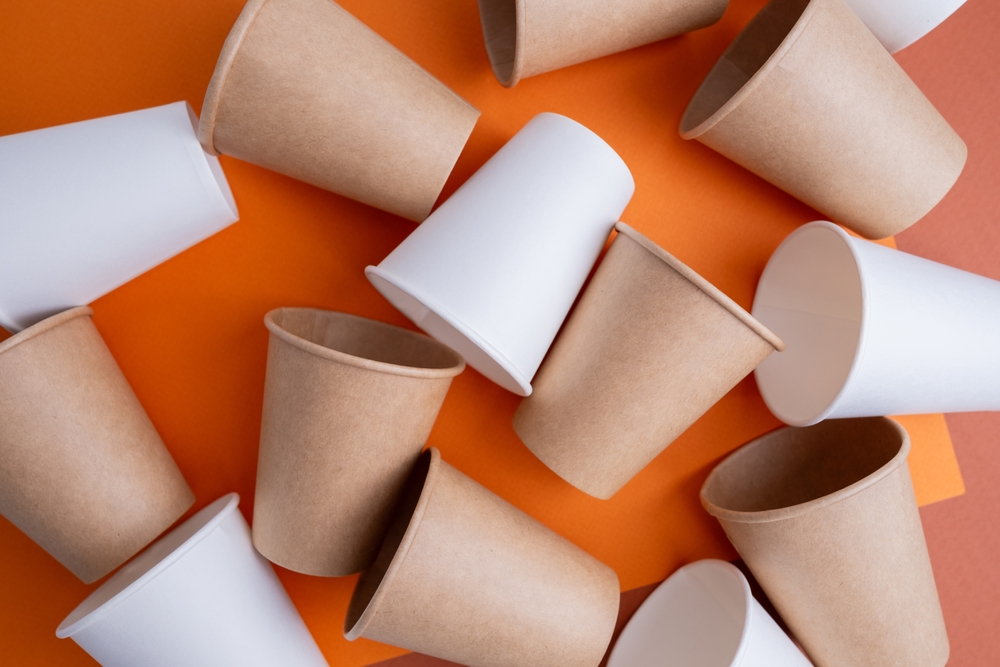Breaking Down Standard vs Kraft Paper Cups for Your Business
By Anttoni Taimela · 27. June 2024
When selecting paper cups, the debate often boils down to standard vs kraft paper cups. What are the differences, and which is better suited to your business needs?
This article directly compares these popular choices, focusing on design, cost, and environmental impact to guide your decision-making process.
We’ll explore how each cup’s features can influence your branding, customer experience, and sustainability goals without overselling or spoiling the comprehensive analysis that follows.
Exploring the Aesthetics: Standard White vs. Natural Kraft
 top view of white and brown kraft paper cups
top view of white and brown kraft paper cups
Customers perceive your brand based largely on aesthetics. Standard white paper cups are known for their pristine, clean aesthetic, making them a versatile choice for various settings and occasions.
On the other hand, kraft paper cups offer a distinctive natural appearance that can help a brand establish a unique identity.
Each type of cup has its own advantages, and the choice between them often depends on your brand’s image and the message you want to convey.
Color and Branding
The neutral backdrop of white paper cups enhances coffee shop logos and branding elements, enriching the overall brand aesthetic for hot drinks and hot beverages.
Custom prints on white cups tend to maintain colour fidelity, ensuring that your branding designs are clear and accurately represented.
This makes them an excellent choice for businesses looking to showcase vibrant colours and intricate designs on both cups and coffee cup lids. ☕️
In contrast, the natural coloration of kraft paper cups can affect the final appearance of prints, with white or light colours appearing less pure.
Kraft cups absorb more ink during printing, which might modify colour perception compared to standard white paper cups.
Despite this, kraft cups can still be a perfect choice for businesses aiming for an earthy, eco-friendly image.
Choosing the right type of paper cup can influence consumer behaviour and brand loyalty, as the colours used significantly impact these factors.
Texture and Tactile Experience
Customer engagement with a brand can be significantly impacted by the texture and feel of a paper cup, which are vital aspects of tactility.
White paper cups are generally recognized for their smooth texture, which can evoke a sense of cleanliness and professionalism when held by customers.
This smoothness can enhance the overall drinking experience, making it more enjoyable for your customers.
On the other hand, kraft paper cups offer a different tactile experience due to their natural texture.
This can give customers a sense of holding something more organic and environmentally friendly, which can positively influence their perception of your brand.
The thickness, feel, and amount of material used in a cup also contribute to how customers perceive its quality and sustainability.
Environmental Considerations: Impact on the Earth 🌍
The manufacturing of each paper cup, part of a production process that includes the felling of millions of trees, results in substantial CO2 emissions, a significant environmental drawback.
However, there are ways to mitigate these impacts.
For instance, producing kraft cups within Europe can lower CO2 emissions during transportation, thus minimising their carbon footprint.
Another consideration is the type of lining used in paper cups. Standard paper cups are traditionally non-recyclable and non-biodegradable due to their petroleum-based plastic lining, which can take decades to decompose in landfills.
Biodegradable plastics like PLA offer a more sustainable alternative, making compostable coffee cups and compostable paper cups, reducing the time needed for decomposition.
Additionally, recyclable coffee cups and paper cup recycling programs allow for repurposing into new products, further reducing environmental harm.
Source Materials
Often, paper cups are made from wood fibre, a renewable resource, sourced from responsibly managed working forests.
These working forests are maintained with sustainable forestry practices, including:
- Replanting trees to ensure future growth
- Protecting wildlife habitats
- Conserving water and soil quality
- Minimising the use of chemicals
In the United States, the pulp and paper industry plants over a billion trees annually as part of its commitment to maintaining forest health.
Kraft paper cups, especially those with FSC-certified wood pulp, cater to the growing eco-conscious consumer base.
By choosing cups made from sustainable materials, businesses can align themselves with the values of environmentally aware customers and contribute to a more sustainable future. 🌱
Cost Analysis: Pricing for Profitability 💰
 beautiful lady holding up a paper cup
beautiful lady holding up a paper cup
Operational efficiencies, including cost savings, can be realised by businesses that use standard paper cups.
The cost savings from using standard paper cups mainly stem from their lower manufacturing costs in comparison to kraft paper cups.
However, custom branding on paper cups is a significant factor that influences consumer purchasing behaviour.
The profitability of a business can be affected by consumers who are likely to choose brands that use custom-branded paper cups.
Bulk Purchasing Differences
Kraft paper cups may have a distinctive cost when ordered in bulk due to their natural appearance and material properties.
The unique features of kraft paper cups that contribute to their cost include their natural appearance and the specific material properties required for their production.
As a result, kraft paper cups often have higher manufacturing costs compared to standard paper cups, which impacts the pricing of large quantity orders.
Customization Costs
Custom printing on kraft paper cups may carry a premium due to their material and production processes compared to standard paper cups.
However, branded paper cups offer flexibility in customization for businesses to promote their brand or special campaigns.
Creating a unique and memorable experience for customers is possible with the powerful marketing tool of flexible customization. 📈
Kraft paper absorbs more colour than traditional white paper, resulting in darker print colours.
This means that businesses might need to invest more in ensuring their designs look as intended on kraft cups.
Despite the higher customization costs, the potential benefits in brand perception and customer loyalty can make it a worthwhile investment.
Meeting Consumer Expectations: Quality and Perception
Perceived quality differences often lead consumers to prefer one type of paper cup over another, as their choices are driven by their expectations of quality.
Eco-friendliness has become a significant factor in consumer decision-making, influencing the choice between standard versus kraft paper cups.
Perceived Value
Double wall cups, including the popular double wall cup, are perceived as having a higher quality appearance and feel compared to single wall cups, such as the single wall paper cup.
The perception of a product’s value is influenced by customers associating the material and design of a single wall cup with its overall quality.
This perceived value can impact customer satisfaction and loyalty, making it an important consideration for businesses.
Eco-Friendly Trends
Trends in sustainable packaging, such as the use of recyclable materials, minimalism, and reusable designs, are shaping consumer preferences.
The movement towards using biodegradable cups is emerging, yet customers are cautioned against misleading claims as not all products marketed as ‘biodegradable’ have a scientific basis for such claims.
Transparency about their sustainability practices and ensuring their products meet the expectations of eco-conscious consumers are crucial for businesses. ♻️
Reusable cups, while offering an alternative to disposable paper cups, come with their own environmental concerns such as hygiene issues, heavier weight impacting shipping emissions, and energy-intensive washing processes.
When deciding on the best approach to meet consumer demands for eco-friendly options, businesses need to weigh these factors.
Summary
In summary, both standard white paper cups and kraft paper cups offer unique advantages and challenges.
Standard white cups provide a clean, versatile look and cost savings, while kraft cups offer a natural, eco-friendly appearance that can enhance brand perception.
Environmental considerations, cost implications, and consumer expectations all play a crucial role in determining the best choice for your business.
Ultimately, the decision comes down to aligning your choice with your brand values and operational goals.
By considering the factors discussed in this guide, you can make an informed decision that benefits both your business and the environment. 🌟
Frequently Asked Questions
What are the main aesthetic differences between standard white and kraft paper cups?
The main aesthetic differences between standard white and kraft paper cups are that white cups offer a clean and versatile look, while kraft cups provide a natural and earthy appearance that can help a brand stand out.
How do the environmental impacts of standard and kraft paper cups compare?
Kraft paper cups have a lower environmental impact compared to standard paper cups, as they can be produced locally and use biodegradable linings. This can result in a lower carbon footprint.
Are there significant cost differences between standard and kraft paper cups?
Yes, kraft paper cups typically have higher manufacturing and customization costs due to their unique material properties and production processes.
How do consumer perceptions of quality differ between single wall and double wall cups?
Consumer perceptions of quality differ between single wall and double wall cups as double wall cups are often viewed as higher quality due to their enhanced insulation and sturdier feel.
What are some common misconceptions about biodegradable and reusable cups?
Not all products labelled as ‘biodegradable’ are scientifically proven to be so, and reusable cups have their own environmental drawbacks, including hygiene issues and higher shipping emissions. It’s essential to critically evaluate claims and consider all factors when choosing environmentally friendly options.

